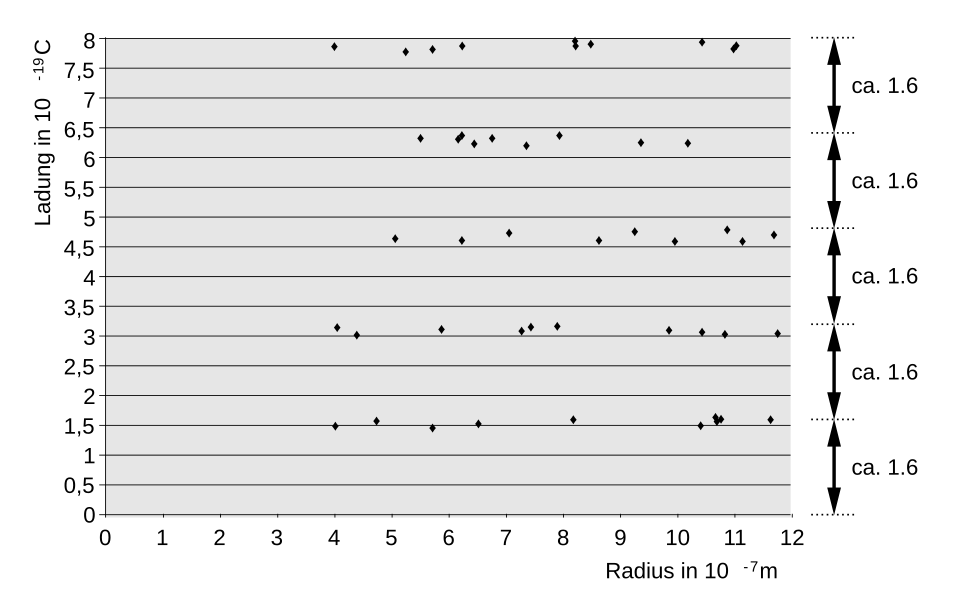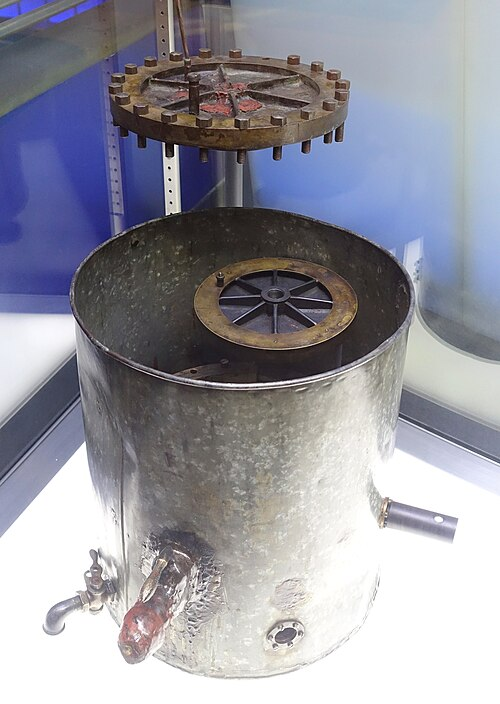OCR Specification focus:
‘Net charge on particles and objects is quantised: always an integer multiple of e.’
Electric charge exists in discrete packets rather than continuous amounts. This fundamental property of matter, known as quantisation of charge, underpins all electrical and atomic interactions.
Understanding Quantisation of Charge
The quantisation of charge means that the net electric charge of any isolated system is always an integer multiple of a fundamental unit of charge. This unit of charge is the elementary charge, represented by the symbol e. It is the smallest amount of free charge that can exist independently, carried by a single proton or electron.
Quantisation of charge: The principle that electric charge can exist only as integer multiples of the elementary charge, e = 1.6 × 10⁻¹⁹ coulombs.
This concept reveals that charge is not infinitely divisible; instead, it appears in discrete packets. For example, the charge of two electrons is −2e, while that of three protons is +3e.
The Elementary Charge
The elementary charge (e) is one of the most fundamental physical constants. It represents the magnitude of the charge carried by a single proton or the negative of that charge carried by an electron.
Elementary charge (e): The smallest indivisible unit of electric charge, equal to 1.6 × 10⁻¹⁹ C.
The elementary charge has been measured experimentally through various methods, most famously by Robert Millikan’s oil drop experiment, which demonstrated that all measured charges were integer multiples of a common value. This confirmed the discrete nature of electric charge.
Protons, Electrons, and Charge Polarity
Every atom contains protons and electrons, which are the fundamental charge carriers in ordinary matter.
Proton: carries a positive charge of +e.
Electron: carries a negative charge of −e.
Neutron: has no net charge, meaning it is electrically neutral.
The sign convention assigns positive to the proton’s charge and negative to the electron’s. The magnitude of their charges is identical, ensuring that a neutral atom has equal numbers of protons and electrons.
When an atom loses or gains electrons, it becomes an ion — a charged particle with a net charge equal to an integer multiple of e.
The Equation for Quantised Charge
The total charge on an object or system can be expressed mathematically as the product of the number of elementary charges and the charge per particle.
EQUATION
—-----------------------------------------------------------------
Quantised Charge (Q) = n e
Q = total charge (C)
n = integer number of excess or deficit charges
e = elementary charge (1.6 × 10⁻¹⁹ C)
—-----------------------------------------------------------------
This equation demonstrates that electric charge cannot take arbitrary values; instead, it increases or decreases in steps of e. For instance, if an object has a charge of 3.2 × 10⁻¹⁹ C, then n = 2, meaning it carries the charge equivalent of two electrons (negative) or protons (positive).

A plot from the Millikan oil-drop analysis in which measured charges fall on discrete levels separated by e. The staircase-like clustering demonstrates that charge is quantised. Extra grid/axis detail beyond the OCR syllabus is included only to make the discreteness visually clear. Source.
Net Charge and Conservation
In any system, net charge is the algebraic sum of all positive and negative charges present. Because each charge is an integer multiple of e, the net charge must also be quantised. This principle extends from single particles to macroscopic objects.
For example:
A charged metal sphere might have a net charge of +5e or −12e, but never +4.3e.
When charges are transferred, they move in discrete amounts, maintaining quantisation.
The law of conservation of charge complements quantisation. It states that charge cannot be created or destroyed — it can only be transferred between bodies. Therefore, while the total charge in a closed system remains constant, it always does so in quantised units of e.
The Nature of Quantisation in Macroscopic Systems
Although quantisation is a fundamental property, in everyday electrical systems it often appears continuous. This is because the elementary charge is extremely small compared with the scale of everyday charge transfers.
Consider:
The charge of a single electron is 1.6 × 10⁻¹⁹ C.
A current of just 1 A transfers approximately 6.25 × 10¹⁸ electrons per second.
Since this number is so large, the individual charge quanta blend into a seemingly continuous flow, even though they are inherently discrete. Thus, while charge quantisation is always true, its effects are only noticeable in microscopic systems, such as in atomic or subatomic physics.
Experimental Evidence for Charge Quantisation
The Millikan oil drop experiment (1909) provided definitive proof of charge quantisation. By observing tiny oil droplets suspended in an electric field, Millikan measured their charges and found all were multiples of a single smallest value, confirming that:
Charge exists in discrete packets.
The elementary charge e = 1.6 × 10⁻¹⁹ C.
No smaller free charge was observed in isolation.
This result remains one of the cornerstones of modern physics, linking atomic theory with electrical phenomena.

Photograph of Millikan’s oil-drop apparatus on display, showing the chamber and instrumentation used to measure the elementary charge. Seeing the actual device reinforces how quantisation was established experimentally. Museum display placarding visible in the image is contextual and does not add syllabus-beyond content. Source.
Situations Exhibiting Charge Quantisation
Charge quantisation is evident in several contexts:
Atomic structure: Electrons and protons possess charges of ±e.
Ions: The total charge of an ion equals the number of electrons lost or gained multiplied by e.
Capacitors and conductors: Even though charges seem continuous, the smallest transferable charge is still e.
Subatomic particles: Quarks have fractional charges (±⅓e or ±⅔e), but they are never found in isolation — only in combinations yielding integer multiples of e.
This reinforces that all observable charges are quantised.
Implications of Quantisation
Quantisation of charge is fundamental to understanding the structure of matter and electrical behaviour. It ensures that:
Atomic and molecular stability is maintained.
Charge transfer processes, such as conduction and ionisation, occur in discrete steps.
Conservation laws in electrical circuits are consistent and predictable.
Without quantisation, atomic stability and predictable electric interactions would not exist, making this principle essential to both classical and modern physics.
FAQ
Quantisation means that observable charge always appears in integer multiples of the elementary charge, e. However, quarks—the building blocks of protons and neutrons—carry fractional charges of +⅔e or −⅓e.
Quarks are never found in isolation; they combine to form hadrons such as protons (2 up quarks and 1 down quark = +e) and neutrons (1 up quark and 2 down quarks = 0).
Thus, while quarks have fractional charges individually, all observable particles have total charges that are integer multiples of e, preserving charge quantisation at the macroscopic level.
Quantisation defines how much charge can exist, while conservation defines what happens to it during interactions.
Quantisation: Charge exists in discrete packets (multiples of e).
Conservation: The total charge in a closed system remains constant.
Together, they mean that when particles interact, any gain or loss of charge happens in whole-number multiples of e, never in fractions or arbitrary amounts.
No experimental evidence has shown a violation of charge quantisation. However, some advanced theories predict that under extreme conditions, such as at very high energies or in the early universe, exotic particles with unusual charge values might exist.
Experiments in particle accelerators and cosmic-ray detection have looked for free particles with fractional charge but none have been confirmed. Therefore, charge quantisation remains a universally observed principle.
In everyday currents, trillions of electrons move each second, and the elementary charge (1.6 × 10⁻¹⁹ C) is extremely small.
The discrete steps of charge transfer are therefore far too tiny to detect—currents and charges appear continuous on the macroscopic scale.
Only in systems involving very few electrons, such as in quantum dots or single-electron transistors, can the quantised nature of charge be directly observed.
Millikan’s original experiment used manual observation through a microscope to balance droplets, producing results accurate to about 1%.
Subsequent improvements included:
More stable voltage supplies.
Refined droplet generation for uniform size.
Automated timing and image capture systems.
Modern versions of the experiment achieve uncertainties below 0.01%, confirming the elementary charge value and further validating the principle of charge quantisation.
Practice Questions
Question 1 (2 marks)
State what is meant by the quantisation of charge and give the value of the elementary charge.
Mark Scheme:
1 mark: States that electric charge can exist only in discrete amounts or integer multiples of a fundamental unit of charge.
1 mark: Gives the value of the elementary charge as 1.6 × 10⁻¹⁹ C.
Question 2 (5 marks)
Explain how the Millikan oil drop experiment provided evidence for the quantisation of electric charge. In your answer, describe the method used to determine the charge on an oil drop and how the results supported the idea of charge quantisation.
Mark Scheme:
1 mark: Mentions that tiny oil droplets were suspended between charged plates in an electric field.
1 mark: States that the balance between gravitational and electric forces allowed calculation of the charge on each droplet.
1 mark: States that the measured charges on different droplets were always multiples of a smallest value (the elementary charge).
1 mark: Identifies that this smallest value corresponded to the charge on a single electron, e = 1.6 × 10⁻¹⁹ C.
1 mark: Concludes that this provided direct experimental evidence that charge is quantised, existing in integer multiples of e.

